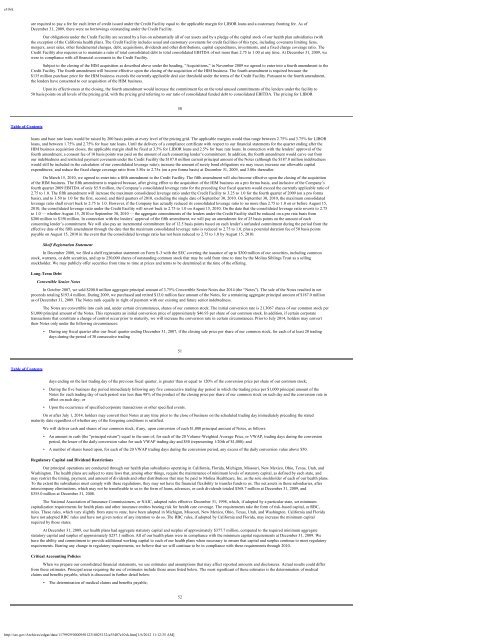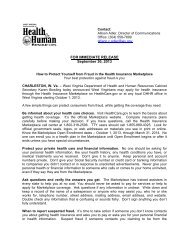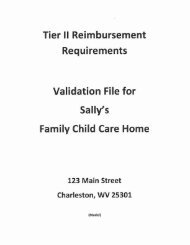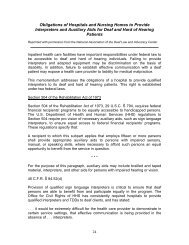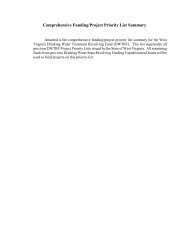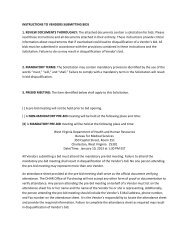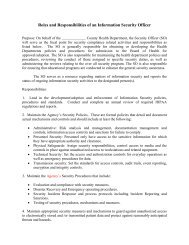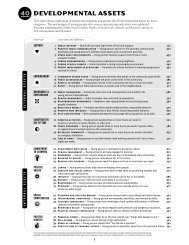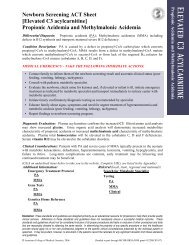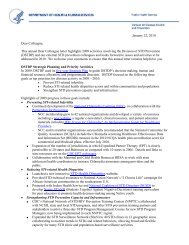Molina Medicaid Solutions - DHHR
Molina Medicaid Solutions - DHHR
Molina Medicaid Solutions - DHHR
Create successful ePaper yourself
Turn your PDF publications into a flip-book with our unique Google optimized e-Paper software.
e10vkare required to pay a fee for each letter of credit issued under the Credit Facility equal to the applicable margin for LIBOR loans and a customary fronting fee. As ofDecember 31, 2009, there were no borrowings outstanding under the Credit Facility.Our obligations under the Credit Facility are secured by a lien on substantially all of our assets and by a pledge of the capital stock of our health plan subsidiaries (withthe exception of the California health plan). The Credit Facility includes usual and customary covenants for credit facilities of this type, including covenants limiting liens,mergers, asset sales, other fundamental changes, debt, acquisitions, dividends and other distributions, capital expenditures, investments, and a fixed charge coverage ratio. TheCredit Facility also requires us to maintain a ratio of total consolidated debt to total consolidated EBITDA of not more than 2.75 to 1.00 at any time. At December 31, 2009, wewere in compliance with all financial covenants in the Credit Facility.Subject to the closing of the HIM acquisition as described above under the heading, “Acquisitions,” in November 2009 we agreed to enter into a fourth amendment to theCredit Facility. The fourth amendment will become effective upon the closing of the acquisition of the HIM business. The fourth amendment is required because the$135 million purchase price for the HIM business exceeds the currently applicable deal size threshold under the terms of the Credit Facility. Pursuant to the fourth amendment,the lenders have consented to our acquisition of the HIM business.Upon its effectiveness at the closing, the fourth amendment would increase the commitment fee on the total unused commitments of the lenders under the facility to50 basis points on all levels of the pricing grid, with the pricing grid referring to our ratio of consolidated funded debt to consolidated EBITDA. The pricing for LIBOR50Table of Contentsloans and base rate loans would be raised by 200 basis points at every level of the pricing grid. The applicable margins would thus range between 2.75% and 3.75% for LIBORloans, and between 1.75% and 2.75% for base rate loans. Until the delivery of a compliance certificate with respect to our financial statements for the quarter ending after theHIM business acquisition closes, the applicable margin shall be fixed at 3.5% for LIBOR loans and 2.5% for base rate loans. In connection with the lenders’ approval of thefourth amendment, a consent fee of 10 basis points was paid on the amount of each consenting lender’s commitment. In addition, the fourth amendment would carve out fromour indebtedness and restricted payment covenants under the Credit Facility the $187.0 million current principal amount of the Notes (although the $187.0 million indebtednesswould still be included in the calculation of our consolidated leverage ratio); increase the amount of surety bond obligations we may incur; increase our allowable capitalexpenditures; and reduce the fixed charge coverage ratio from 3.50x to 2.75x (on a pro forma basis) at December 31, 2009, and 3.00x thereafter.On March 15, 2010, we agreed to enter into a fifth amendment to the Credit Facility. The fifth amendment will also become effective upon the closing of the acquisitionof the HIM business. The fifth amendment is required because, after giving effect to the acquisition of the HIM business on a pro forma basis, and inclusive of the Company’sfourth quarter 2009 EBITDA of only $5.9 million, the Company’s consolidated leverage ratio for the preceding four fiscal quarters would exceed the currently applicable ratio of2.75 to 1.0. The fifth amendment will increase the maximum consolidated leverage ratio under the Credit Facility to 3.25 to 1.0 for the fourth quarter of 2009 (on a pro formabasis), and to 3.50 to 1.0 for the first, second, and third quarters of 2010, excluding the single date of September 30, 2010. On September 30, 2010, the maximum consolidatedleverage ratio shall revert back to 2.75 to 1.0. However, if the Company has actually reduced its consolidated leverage ratio to no more than 2.75 to 1.0 on or before August 15,2010, the consolidated leverage ratio under the Credit Facility will revert back to 2.75 to 1.0 on August 15, 2010. On the date that the consolidated leverage ratio reverts to 2.75to 1.0 — whether August 15, 2010 or September 30, 2010 — the aggregate commitments of the lenders under the Credit Facility shall be reduced on a pro rata basis from$200 million to $150 million. In connection with the lenders’ approval of the fifth amendment, we will pay an amendment fee of 25 basis points on the amount of eachconsenting lender’s commitment. We will also pay an incremental commitment fee of 12.5 basis points based on each lender’s unfunded commitment during the period from theeffective date of the fifth amendment through the date that the maximum consolidated leverage ratio is reduced to 2.75 to 1.0, plus a potential duration fee of 50 basis pointspayable on August 15, 2010 in the event that the consolidated leverage ratio has not been reduced to 2.75 to 1.0 by August 15, 2010.Shelf Registration StatementIn December 2008, we filed a shelf registration statement on Form S-3 with the SEC covering the issuance of up to $300 million of our securities, including commonstock, warrants, or debt securities, and up to 250,000 shares of outstanding common stock that may be sold from time to time by the <strong>Molina</strong> Siblings Trust as a sellingstockholder. We may publicly offer securities from time to time at prices and terms to be determined at the time of the offering.Long-Term DebtConvertible Senior NotesIn October 2007, we sold $200.0 million aggregate principal amount of 3.75% Convertible Senior Notes due 2014 (the “Notes”). The sale of the Notes resulted in netproceeds totaling $193.4 million. During 2009, we purchased and retired $13.0 million face amount of the Notes, for a remaining aggregate principal amount of $187.0 millionas of December 31, 2009. The Notes rank equally in right of payment with our existing and future senior indebtedness.The Notes are convertible into cash and, under certain circumstances, shares of our common stock. The initial conversion rate is 21.3067 shares of our common stock per$1,000 principal amount of the Notes. This represents an initial conversion price of approximately $46.93 per share of our common stock. In addition, if certain corporatetransactions that constitute a change of control occur prior to maturity, we will increase the conversion rate in certain circumstances. Prior to July 2014, holders may converttheir Notes only under the following circumstances:• During any fiscal quarter after our fiscal quarter ending December 31, 2007, if the closing sale price per share of our common stock, for each of at least 20 tradingdays during the period of 30 consecutive trading51Table of Contentsdays ending on the last trading day of the previous fiscal quarter, is greater than or equal to 120% of the conversion price per share of our common stock;• During the five business day period immediately following any five consecutive trading day period in which the trading price per $1,000 principal amount of theNotes for each trading day of such period was less than 98% of the product of the closing price per share of our common stock on such day and the conversion rate ineffect on such day; or• Upon the occurrence of specified corporate transactions or other specified events.On or after July 1, 2014, holders may convert their Notes at any time prior to the close of business on the scheduled trading day immediately preceding the statedmaturity date regardless of whether any of the foregoing conditions is satisfied.We will deliver cash and shares of our common stock, if any, upon conversion of each $1,000 principal amount of Notes, as follows:• An amount in cash (the “principal return”) equal to the sum of, for each of the 20 Volume-Weighted Average Price, or VWAP, trading days during the conversionperiod, the lesser of the daily conversion value for such VWAP trading day and $50 (representing 1/20th of $1,000); and• A number of shares based upon, for each of the 20 VWAP trading days during the conversion period, any excess of the daily conversion value above $50.Regulatory Capital and Dividend RestrictionsOur principal operations are conducted through our health plan subsidiaries operating in California, Florida, Michigan, Missouri, New Mexico, Ohio, Texas, Utah, andWashington. The health plans are subject to state laws that, among other things, require the maintenance of minimum levels of statutory capital, as defined by each state, andmay restrict the timing, payment, and amount of dividends and other distributions that may be paid to <strong>Molina</strong> Healthcare, Inc. as the sole stockholder of each of our health plans.To the extent the subsidiaries must comply with these regulations, they may not have the financial flexibility to transfer funds to us. The net assets in these subsidiaries, afterintercompany eliminations, which may not be transferable to us in the form of loans, advances, or cash dividends totaled $368.7 million at December 31, 2009, and$355.0 million at December 31, 2008.The National Association of Insurance Commissioners, or NAIC, adopted rules effective December 31, 1998, which, if adopted by a particular state, set minimumcapitalization requirements for health plans and other insurance entities bearing risk for health care coverage. The requirements take the form of risk-based capital, or RBC,rules. These rules, which vary slightly from state to state, have been adopted in Michigan, Missouri, New Mexico, Ohio, Texas, Utah, and Washington. California and Floridahave not adopted RBC rules and have not given notice of any intention to do so. The RBC rules, if adopted by California and Florida, may increase the minimum capitalrequired by those states.At December 31, 2009, our health plans had aggregate statutory capital and surplus of approximately $377.7 million, compared to the required minimum aggregatestatutory capital and surplus of approximately $257.1 million. All of our health plans were in compliance with the minimum capital requirements at December 31, 2009. Wehave the ability and commitment to provide additional working capital to each of our health plans when necessary to ensure that capital and surplus continue to meet regulatoryrequirements. Barring any change in regulatory requirements, we believe that we will continue to be in compliance with these requirements through 2010.Critical Accounting PoliciesWhen we prepare our consolidated financial statements, we use estimates and assumptions that may affect reported amounts and disclosures. Actual results could differfrom these estimates. Principal areas requiring the use of estimates include those areas listed below. The most significant of these estimates is the determination of medicalclaims and benefits payable, which is discussed in further detail below:• The determination of medical claims and benefits payable;52http://sec.gov/Archives/edgar/data/1179929/000095012310025132/a55407e10vk.htm[1/6/2012 11:12:35 AM]


